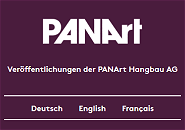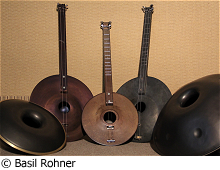In a topic on handpan.org  user G.Spence asked today about “retuning a Free Integral Hang to 440 or 432 Hertz” and if “it actually improve its sound by ‘readjusting’ the harmonics”.
user G.Spence asked today about “retuning a Free Integral Hang to 440 or 432 Hertz” and if “it actually improve its sound by ‘readjusting’ the harmonics”.
When I visited the steelpan tuner Eckhard Schulz a year ago he took my Free Integral Hang and checked it with his tuning devices. Then his verdict was: “There is nothing correct. They cannot tune in Bern.” There are many who like Eckhard Schulz have difficulties to understand the how and why of PANArt’s free tuning.
I want to draw your attention to the paragraphs in Felix Rohner’s review  of Anthony Achong’s standard work “The Secrets of the Steelpan” where he wrote about Achong’s explanation about the importance of the modulations of the partial tones (modes): “This art is primarily about the modulation of the partial tones that makes the steelpan sound spirited and livelily. In absence of this modulation the resulting sound will be dead. The instrument will drain energy from the player even if the sounds have harmonic qualities.”
of Anthony Achong’s standard work “The Secrets of the Steelpan” where he wrote about Achong’s explanation about the importance of the modulations of the partial tones (modes): “This art is primarily about the modulation of the partial tones that makes the steelpan sound spirited and livelily. In absence of this modulation the resulting sound will be dead. The instrument will drain energy from the player even if the sounds have harmonic qualities.”
This may help to understand the physics of free tuning and why “readjusting the harmonics” will never improve the sound but destroy the tuner’s work because there is a physical reason why the modes (harmonics as G.Spence called them) have to be detuned.
Achong emphasizes that detuning is not mistuning. On pp. 862-889 in his book you will find the theoretical basis for PANArt’s free tuning. Achong explains that detuning of the modes is necessary, that it is the main parameter used by the tuner to design the sound dynamics by amplitude and frequency modulation. In fact – as Achong demonstrates – no tuner is tuning really exactly although many of them don’t realise it. If a tuner would tune exactly, his instruments would sound very bad and muffled.
If you have understood Achong’s theory about detuning you will understand why it doesn’t make sense to evaluate the quality of the tuning of a steelpan like instrument by tuning devices and that PANArt’s free tuning is nothing exotic. It is based on decades old practices of Trinidad’s tuners and follows this path just a little step further. Achong’s analysis of detuning draws the attention of tuners and players to the tuning quality beyond harmonic correctness that currently dominates the talks in the handpan community.
There is an explanation in Wikipedia  that possibly also helps to understand PANArt’s free tuning.
that possibly also helps to understand PANArt’s free tuning.
Readers who understand German will find additional explanations in two articles in the Hanglexikon: Die Schwingungsmoden der Hang-Stimmen  and Freie Einstimmung
and Freie Einstimmung  .
.
 Du brauchst aber immer noch gute Lautsprecher oder Kopfhörer um in den Audios und Videos den wichtigen Bassklang (die Helmholtz-Resonanz
Du brauchst aber immer noch gute Lautsprecher oder Kopfhörer um in den Audios und Videos den wichtigen Bassklang (die Helmholtz-Resonanz  ) von Gubal und Hang Gudu wahrnehmen zu können. Eingebaute Lautsprecher in Tablets, Smartphones und Notebooks und die meisten Ohrhörer versagen dabei völlig.
) von Gubal und Hang Gudu wahrnehmen zu können. Eingebaute Lautsprecher in Tablets, Smartphones und Notebooks und die meisten Ohrhörer versagen dabei völlig. 

 News by PANArt about the
News by PANArt about the 